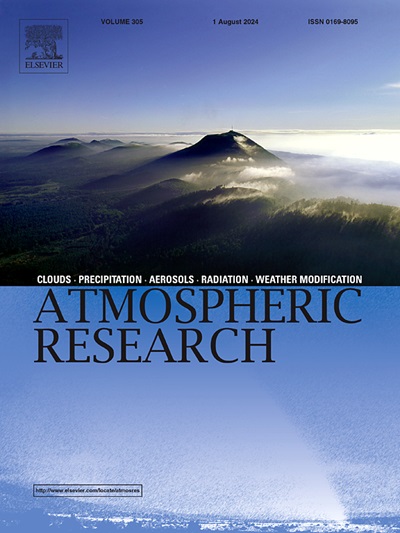21世纪初以后,格陵兰海秋冬海冰与印度夏季风降雨之间的关系增强
IF 4.5
2区 地球科学
Q1 METEOROLOGY & ATMOSPHERIC SCIENCES
引用次数: 0
摘要
本文研究了1980-2023年北极海冰浓度(SIC)与印度夏季风降水(ISMR)关系的时间变化。1980-2001年期间,ISMR与之前的10 - 11 - 12 - 1月(OND(−1)J(0))不显著相关,而2002-2023年期间,ISMR与格陵兰海SIC (GSSIC)呈显著正相关。在后一时期,在OND(−1)J(0)之前,GSSIC的增加可以施加从北大西洋到东北太平洋的波列,分别在夏威夷东北部和墨西哥西南部诱发异常反气旋和气旋。这反过来又在东北太平洋产生偶极海温异常(SSTA),夏威夷东北部海温为正,墨西哥西南部海温为负。风-蒸发-海温(WES)反馈有助于维持这一偶极海温直到接下来的6 - 7月- 8 - 9月,造成热带中北部太平洋(NCTP)海温负。负的NCTP海温会通过调节Walker环流引起西太平洋-印度洋上空的异常上升运动,最终导致ISMR增加。与2002 ~ 2023年相比,1980 ~ 2001年GSSIC与北大西洋偶极子(NAD)海温的共变更强。由于大气环流异常对GSSIC的响应与对NAD SSTA的响应几乎相反,因此GSSIC异常对北半球波列的影响受到干扰。因此,GSSIC异常对东北太平洋海温的影响较小,导致GSSIC- ismr关系减弱。本文章由计算机程序翻译,如有差异,请以英文原文为准。
Enhanced relationship between preceding autumn-winter sea ice over Greenland Sea and following Indian Summer Monsoon rainfall after early-2000s
The present study investigates the temporal variation in the connection between Arctic sea ice concentration (SIC) and Indian summer monsoon rainfall (ISMR) during 1980–2023. The ISMR shows an insignificant correlation with the preceding October–November–December–January (OND(−1)J(0)) Greenland Sea SIC (GSSIC) during 1980–2001, whereas the relationship turns to be significant positive during 2002–2023. During this latter period, the increasing GSSIC in preceding OND(−1)J(0) can exert wave trains that travel from North Atlantic to northeast Pacific, inducing anomalous anticyclone and cyclone over northeast of Hawaii and southwest of Mexico, respectively. This, in turn, generates a dipole sea surface temperature anomalies (SSTA) over northeast Pacific, with positive SSTA northeast of Hawaii and negative SSTA southwest of Mexico. The Wind-Evaporation-SST (WES) feedback helps maintain this dipole SSTA through to the following June–July–August–September, contributing to the negative SSTA over north central tropical Pacific (NCTP). The negative NCTP SSTA can induce anomalous ascending motion over the western Pacific–Indian Ocean by modulating Walker circulation, ultimately leading to increase ISMR. In contrast, during 1980–2001, GSSIC shows stronger co-variation with North Atlantic dipole (NAD) SSTA compared with that during 2002–2023. Due to the response of atmospheric circulation anomalies to the GSSIC are nearly opposite to those in terms of the NAD SSTA, the influence of the GSSIC anomalies on the wave trains over Northern Hemisphere is disturbed. Therefore, the GSSIC anomalies can slightly impact on the SSTA over northeast Pacific, resulting in weaker GSSIC-ISMR relationship.
求助全文
通过发布文献求助,成功后即可免费获取论文全文。
去求助
来源期刊

Atmospheric Research
地学-气象与大气科学
CiteScore
9.40
自引率
10.90%
发文量
460
审稿时长
47 days
期刊介绍:
The journal publishes scientific papers (research papers, review articles, letters and notes) dealing with the part of the atmosphere where meteorological events occur. Attention is given to all processes extending from the earth surface to the tropopause, but special emphasis continues to be devoted to the physics of clouds, mesoscale meteorology and air pollution, i.e. atmospheric aerosols; microphysical processes; cloud dynamics and thermodynamics; numerical simulation, climatology, climate change and weather modification.
 求助内容:
求助内容: 应助结果提醒方式:
应助结果提醒方式:


